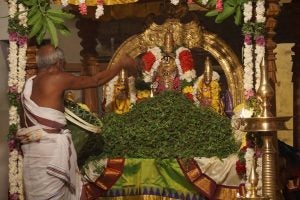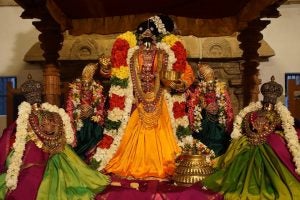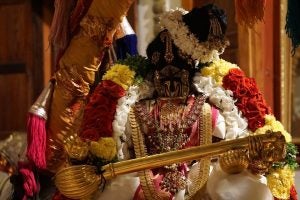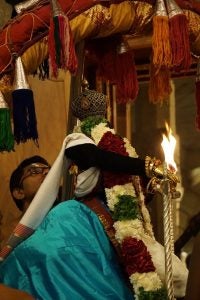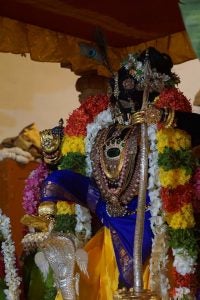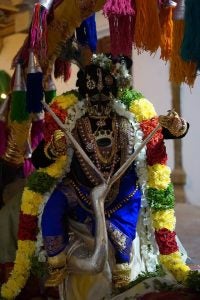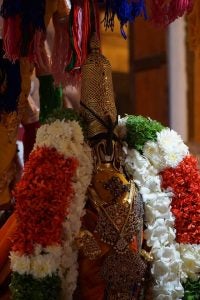Vaikuntha Ekadasi (Dec 29)
Adhyayanotsavam Day 11
Ira Pattu Day 1
Text: Tiruvaymoli First 100 (recited while seated)
Text (Iyarpa): Poykai: Mutal Tiruvantati (recited in procession)

It is impossible to describe Vaikuntha Ekadasi. Suffice it to say, it is a complete sensory overload. I’ve experienced this particular day at a few temples, and I keep coming back to space and how space shapes your experience. There is also time of course–the day is packed. You begin at 3 AM and go, go, go, without a pause. The day thus has this curious feeling of moving very, very slowly because you’re building to the climactic opening of the Vaikuntha Vasal–god descending, the alvar there to meet him, and the rest of us poor, confused folks just carried along in the sea of surging humanity, with all of its sorrows and joys. At the same time, you’re moving so fast through the day, with one event following the next, that you feel like you’re living on fast forward.
Herein Tirukkurungudi, the vasal (doorway) on the northern side is set between a rabbit-warren of granite pillars. So a crowd of some 1000+ people squeeze in, trying to get glimpse. There’s a tall, narrow door through which everyone must pass, following Vishnu. Tirumankai awaits on the other side, held aloft, above all of us, so Nambi and he can see each other directly, with nothing and no one to obscure the view. There is a sense of urgency and intimacy that such space creates–so different from my experience at a temple like Sri Vaikuntham, with its rather wide prakara. But wherever you are, the doorway is narrow–and passing through it on this day is a bit like being born–forcing your way through a tight space to new vastness. You are indeed transformed–you must become something else on the other side. God too is transforming–he passes the gateway to confront himself in another form–Tirumankai who is really Nammalvar who is really Nambi. How many layers of identity, of self, of knowing there are! I marvel at this, even as I am running around trying to find a proper vantage. I briefly see myself through the eyes of those gathered, and come up away with the impression of a lunatic in a sari, running blindly. Never more am I an alvar poem.
The bells are clanging, so many different drums are beating, a conch is blowing, people are chanting Govinda Govinda Govinda Govinda, and each time the name just crests on the other–an antati of chanting, looping, looping, looping. Infinity in the name. There are massive, massive oil flames leaping up to touch the stone ceiling, light glancing off the jewels adorning the deity. Someone is earnestly waving a fan to cool the god. I don’t think it’s much help, but I suppose, it’s the thought and the action that count. Amidst all of this, I am trying to take photographs. I am weaving my way through a crowd so dense that it seems they’ve all merged into a single body. At times, I cannot breathe. I am drenched in sweat, a welcome treat to the mosquitoes that will feast on me later that night. My ears are ringing. I hear Vedic chanting low and deep, valiantly trying to keep up with the frenzy of Govinda Govinda Govinda Govinda. I think of Andal’s parrot crying this out. She thinks a taunt–a name she longs to hear, but brings so much pain. Yes, this is what it feels like to live in an alvar poem.
I am glad that Selvaprakash, our team member photographer, working on an allied project, is with me. I know if I don’t get a shot, he most certainly will. I am comforted by this, and by knowing that I’ll go through this ritual 9 more times, and eventually I’ll get what I need. It’s a great lesson in knowing that one has many chances to get it right. You are born again and again and again. Eventually, you’ll go through the door and come out properly formed on the other end.
The sounds, the smells, the sights just fill my body, and then I just sweat it all out–is this what poets mean when they say the self dissolves? I am melting in the heat, in the fire, in the crowd. After the stillness that descended the previous night after Tirumankai’s moksam, this seems to have dialed up the emotional register to about 50 million. This is lunatic overload as David Shulman would say.
Nambi processes the narrow corridors. I am lost in the crowds, and he is a far away blip, illuminated only by the towering flames. An alvar poem.
It is ever thus.



